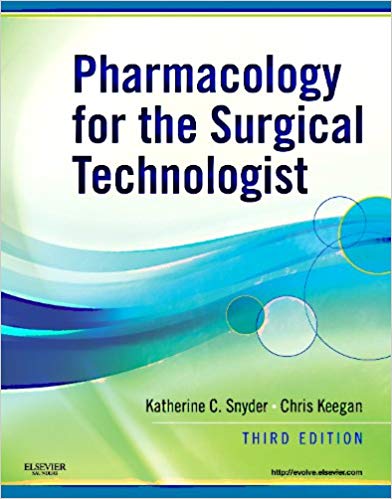Test Bank For Pharmacology for the Surgical Technologist 3rd Edition By Katherine C. Snyder
Original price was: $75.00.$20.00Current price is: $20.00.
Test Bank for Pharmacology for the Surgical Technologist, 3rd Edition by Katherine C. Snyder is a comprehensive resource that covers all of the major drugs used in surgical procedures. The book provides detailed information on each drug, including its mechanism of action, indications, contraindications, side effects, and dosage.
In addition, the book includes review questions at the end of each chapter to help readers test their understanding of the material. The Test Bank for Pharmacology for the Surgical Technologist, 3rd Edition by Katherine C. Snyder is an essential resource for anyone preparing for a career in surgical technology.
Digital item No Waiting Time Instant Download
ISBN-13: 978-1437710021 ISBN-10: 1437710026
Description
Test Bank For Pharmacology for the Surgical Technologist 3rd Edition By Katherine C. Snyder
Snyder & Keegan: Pharmacology for the Surgical Technologist, 3rd Edition
Chapter 02: Medication Development, Regulation, and Resources
MULTIPLE CHOICE
1. Which federal action sets the standards for quality and requires proper medication labeling for preparations containing morphine?
a.
Durham-Humphrey Amendments
b.
Food, Drug, and Cosmetic Act
c.
Pure Food and Drug Act
d.
Controlled Substances Act
ANS: C
The Pure Food and Drug Act of 1906 requires all drugs marketed in the United States to meet minimal standards of uniform strength, purity, and quality. This Act requires all preparations containing morphine to be labeled as such.
DIF: 1 REF: 27
2. Drugs that are listed with a C-I are considered to:
a.
Have a high-abuse potential with no medical use
b.
Be appropriate for postoperative pain control
c.
Have a low-abuse potential (e.g., steroids)
d.
Be available over the counter
ANS: A
The Schedules of Controlled Substances established drugs with high abuse potential as C-I.
DIF: 1 REF: 28
3. Which government agency was established to enforce the Controlled Substances Act?
a.
Occupational Safety and Health Administration (OSHA)
b.
The U.S. Food and Drug Administration (FDA)
c.
The Drug Enforcement Agency (DEA)
d.
The Joint Commission
ANS: C
The Controlled Substances Act established the DEA to enforce its requirements and controls.
DIF: 1 REF: 28
4. All of the following are on the “Do Not Use” list of abbreviations except:
a.
U for unit
b.
The trailing zero
c.
QD for once daily
d.
Zero before the decimal point.
ANS: D
The Joint Commission established a “Do Not Use” list of abbreviations that includes U for unit, the trailing zero, and the abbreviation, QD. The use of a zero before the decimal point is a recommended practice.
DIF: 1 REF: 31
5. Nonprescription medications are also known as which one of the following?
a.
Addictive medications
b.
Over-the-counter medications
c.
Controlled substances
d.
Schedule C-II medications
ANS: B
Medications that do not require prescriptions are called over-the-counter medications.
DIF: 1 REF: 27
6. All of the following are disadvantages to pharmacogenetics except:
a.
Its use to target specific diseases
b.
The complexity of their development
c.
The cost of genetic research
d.
Educating health care providers to their use
ANS: A
Pharmacogenetics can be used to target specific diseases. This technologic advantage makes pharmacogenetics important.
DIF: 2 REF: 33
7. Who assigns a brand name to a new medication?
a.
The FDA
b.
Manufacturer
c.
Pharmacist
d.
Drug reference publishers
ANS: B
The manufacturer’s name for a medication is called the brand or trade name.
DIF: 1 REF: 33
8. A medication’s generic name is:
a.
Never capitalized on the label
b.
Followed by the registered trademark (®) symbol
c.
Its formula
d.
Its proprietary name
ANS: A
The generic name is not owned by any one company and is not capitalized.
DIF: 1 REF: 33
9. On some medication labels, the generic name is:
a.
Placed inside parentheses
b.
Capitalized
c.
Not required
d.
Most prominent
ANS: A
The generic name may be placed directly under the brand name or in parentheses.
DIF: 1 REF: 33
10. The full quantity contained in a medication bottle is its:
a.
Control number
b.
Administration route
c.
Total volume
d.
Supply dosage
ANS: C
The full quantity of a medication in the bottle is known as its total volume.
DIF: 1 REF: 34
11. The organization that internationally regulates medications is:
a.
The Joint Commission
b.
FDA
c.
OSHA
d.
The World Health Organization
ANS: D
The World Health Organization is a specialized agency of the United Nations and is the international regulatory agency for medications.
DIF: 1 REF: 27
12. The identifying number on every prescription that is required by federal law is called the:
a.
National Drug Code
b.
Label alert
c.
Barcode symbol
d.
Lot number
ANS: A
The identifying number on every prescription that is required by federal law is the National Drug Code.
DIF: 1 REF: 35
COMPLETION
1. Which categories of medications under the FDA’s pregnancy categories are considered to be within safe limits for use during pregnancy?
ANS:
A and B
The FDA’s Pregnancy Categories list A and B as either “no risk” (category A) or “little to no risk” (category B), respectively.
DIF: 1 REF: 30
2. In the phases of human medication testing, what is the last phase?
ANS:
Postmarket
The last phase in medication testing on humans is phase IV or postmarket study, which occurs after the medication is released for use in the treatment of a specified condition.
DIF: 1 REF: 32





Be the first to review “Test Bank For Pharmacology for the Surgical Technologist 3rd Edition By Katherine C. Snyder”